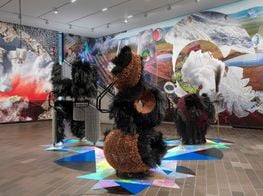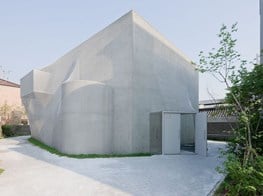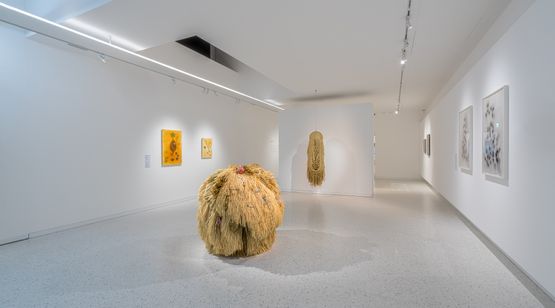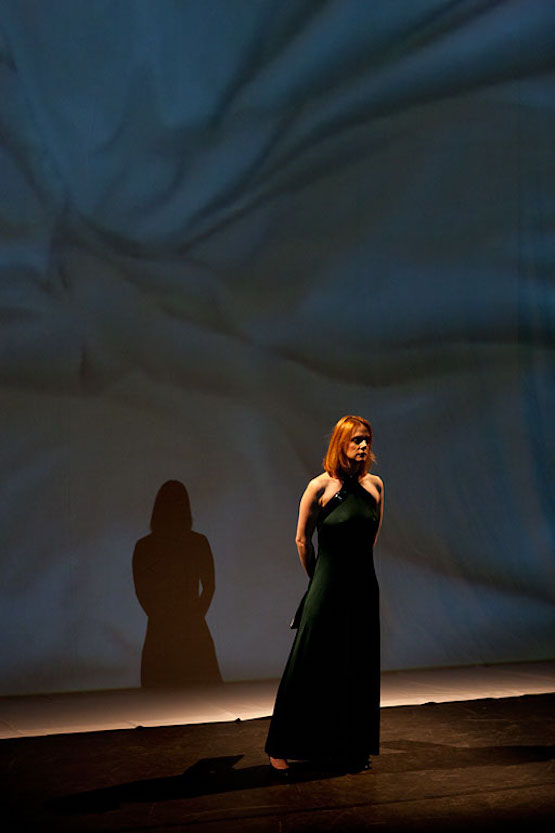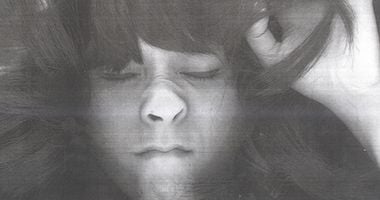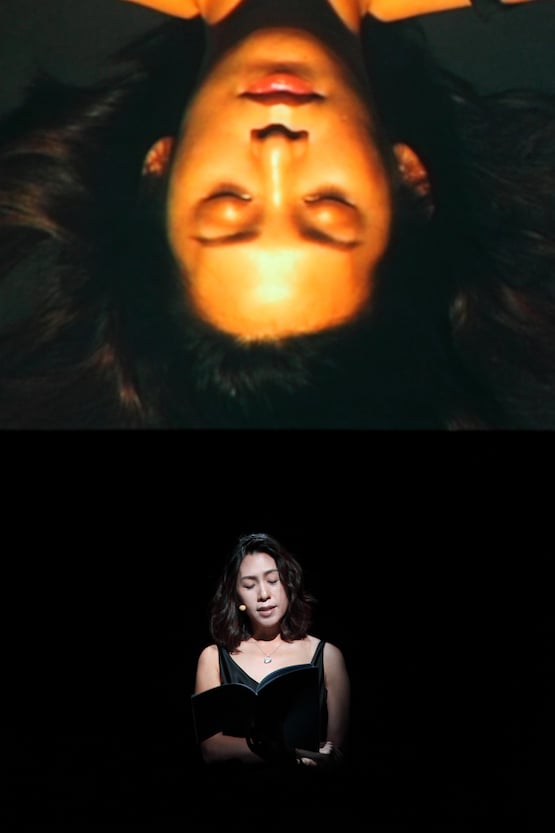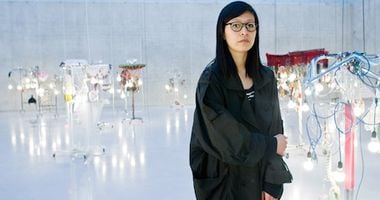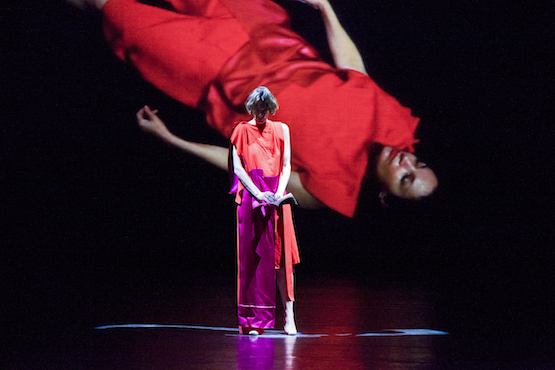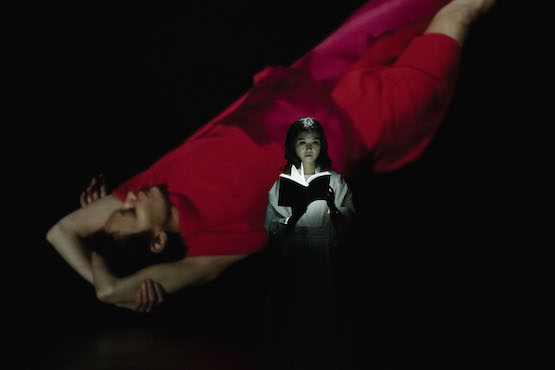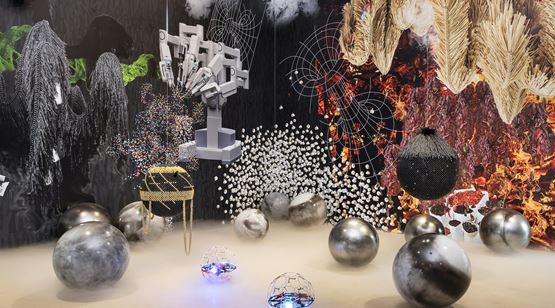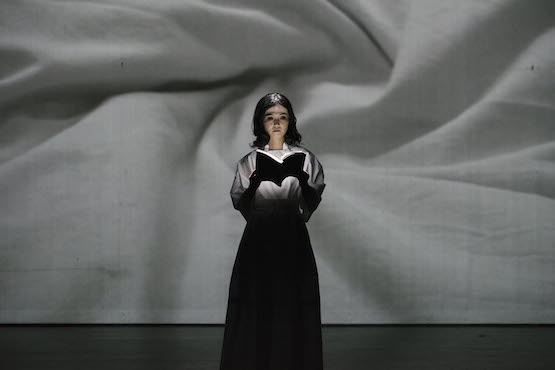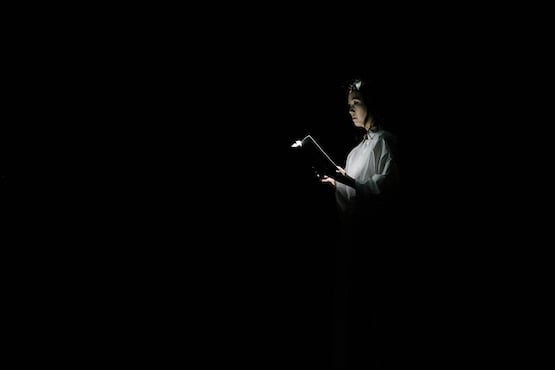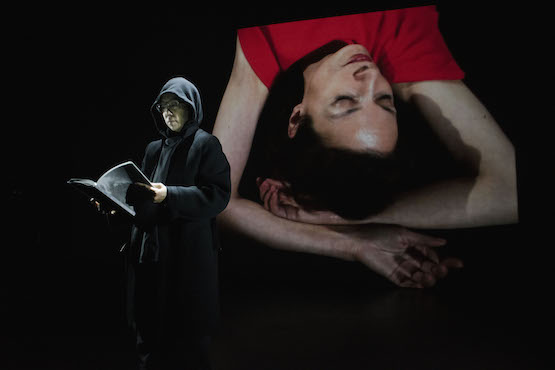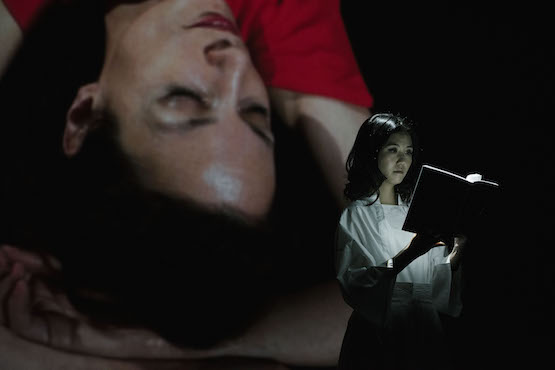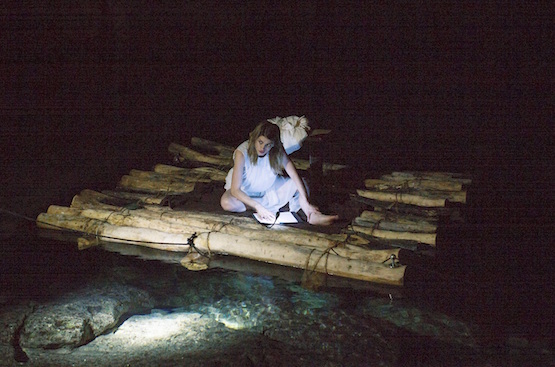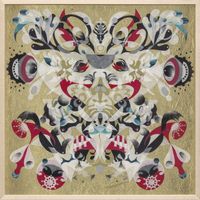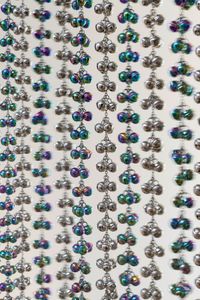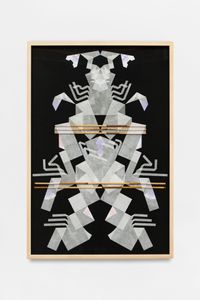Haegue Yang: The Malady of Death
Haegue Yang. Photo: © Studio Haegue Yang

Haegue Yang. Photo: © Studio Haegue Yang
For Haegue Yang, 2015 was a rather hectic year. Along with participating in major art events, such as the Biennale de Lyon, the Sharjah Biennial, and the 8th Asia Pacific Triennial of Contemporary Art, Yang has also put together four solo shows around the world; including two extensive institutional exhibitions in Asia at the Ullens Center for Contemporary Art, Beijing, and the Leeum, Samsung Museum of Art, Seoul.
Working across a broad range of mediums, from ethereal Venetian blind installations and sculptures made of clothing racks, straw and bells, to video and works on paper, Yang's hybrid practice creates a multitude of sensorial experiences that serve to reconfigure and explore the quotidian.
This strong visual language and conceptual drive, combined with Yang's increasing international presence, has meant that her practice has become clearly identifiable.
Yet alongside the widely recognised aspects of her oeuvre, the South Korean born artist has been working on a lesser-known creative trajectory. Driven by a quest for a deeper level of understanding, Yang has staged a series of readings of the French writer Marguerite Duras' 1982 novella The Malady of Death, while also initiating translations of the text, first into Korean in 2008 and now in Chinese.
Beginning in 2010 during her residency at the Walker Art Center in Minneapolis in the United States, each performance has been in a different or local language, with a different performer and with various visual outcomes. Echoing Duras' original text, Yang's staging of The Malady of Death is characterised by an inconclusive uncertainty and the unknown.
Motivated by a passionate, or even obsessive, yearning to comprehend and explore the true meaning of Duras' text, the performative outcome is autonomous from the refined aesthetic of Yang's other work, all the while sharing the same desire to pursue the notion of 'unknown other'.
In December 2015, as part of Mobile M+: Live Art, Yang presented The Malady of Death: Écrire et Lire, which was comprised of a staging of The Malady of Death at Hong Kong's Sunbeam Theatre and the publication of the first Chinese translation.
Held over two nights, the opening performance saw Hon Lai-chu recite Duras' text, dressed in a long white dress upon an all but black stage. Broken up by tension-filled pauses, a burning mosquito coil, moving lights and an intermittent bold background image of French actress Jeanne Balibar, the staging was powerfully effective. It opened up a multitude of considerations for a text that continues to intrigue.
Expanding on a previous Ocula Conversation with Yang, which explored her sculpture and installation work, Katie Fallen sat down with the artist to discuss The Malady of Death; what inspires this unusual practice, how it has developed over the years, and the complex meanings behind Yang's decisive commitment to the project.
Yang's hybrid practice creates a multitude of sensorial experiences that serve to reconfigure and explore the quotidian.
KFThe Malady of Death: Écrire et Lire focuses on Marguerite Duras' novella from 1982. Please can we discuss what drew you to Duras' work as a source of inspiration and this text in particular?
HYWhile I was in search of a notion of community, I encountered an essay by Maurice Blanchot, called The Unavowable Community. There was one chapter, called 'The Community of Lovers', which was impossible to digest since the whole chapter was about a book, unknown to me till then, by Marguerite Duras called The Malady of Death.
So I had to read this book, but I couldn't understand it. Then I read it again, twice in a row, but I still didn't understand what was going on, even though there is nothing theoretical about it. So the whole trajectory about Duras started from this point of not understanding her work.
Initially, I started to study all her novels as well as her biography, and there were many other things that I discovered along the way, such as her films and theatre productions as well as the intertextuality of her works.
Anyway, after two years I returned to The Malady of Death, and initiated the Korean translation of the book. When I was in residency at the Walker from 2009 to 2010, Doryun Chong proposed to stage this book and obviously, I wanted to hear the text translated into the voice ... so it is born out of curiosity to hear Duras' writing.
The conceptual premise of staging this text over and over again was immediately there; it is a kind of blind commitment to make a circle around somewhere that is unknown and even supposed to remain unknown. I'm not sharing what I know; I rather attempt to share what I don't know.
KFThe performance in Hong Kong is the fourth of this work. It was initially staged in 2010 at the Walker Art Center in Minneapolis, then the Namsan Arts Center in Seoul and more recently at dOCUMENTA (13) in 2012. Would you talk us through how you have changed the performance each time, building up to the version in Hong Kong?
HYSo the first stage, which took place at the Walker as a dress rehearsal with invited guests, I have already introduced. T
he second performance of The Malady of Death at the Namsan Arts Center was the first public staging, and was born out of my solo show Voice Over Three, which was in fact my first institutional show in Seoul at Artsonje Center in 2010. Prior to the performance at Namsan, I published a Korean translation of The Malady of Death as an artist book with Insa Art Space in Seoul in 2008.
The team had to be built for it: a Korean philosopher who is known as a specialist in Blanchot was asked to write the preface and a Dutch design collective, Metahaven [Daniel van der Velden] was asked to design the book. Daniel liked the conceptual premise behind the design commission, which illuminated his illiteracy in Korean letters, inducing an element of unknown-ness and impossibility in his job.
The staging at Namsan was an interesting experience because it was the first time I had gone through the proper casting process. I ended up asking a woman to perform who is known in Korea as a news anchor. The main trigger for choosing her was her willingness and her physical presence on the stage, as well as her great ability to perform the text through her trained speech.
KFAfter Namsan, you then staged the work at dOCUMENTA (13). How did this build upon what you had done in Korea?
HYThen the staging at dOCUMENTA (13) in 2012 was a big turning point. So far I had written a script based on the novella for each staging, meaning it was not a complete reading of the book. When I met with the actress for dOCUMENTA (13), Jeanne Balibar, to share my desire and approach to the text, I realised she also had a tremendous relationship with it.
As someone who had grown up in Paris in an intellectual environment she was fairly acquainted with Duras and her writings, but also had a particular approach.
Each performer is the source of the inspiration as well as a strong collaborator, encouraging me to make each version unique. Jeanne was the one who proposed to read the entire text. So the decision to abandon the script was initiated by her.
While I was aware of that possibility the whole time, due to my enormous respect for Duras' text staging it by reading the whole text has been terrifying. However, I followed Jeanne's idea because that was daring and truly challenging. And it was certainly a big turning point.
KFAnd turning then to the performance in Hong Kong?
HYAgain we had two intellectual and strong women: the writer and novelist, Hon Lai-chu; and Yau Ching, the cinema scholar and filmmaker. They're not performers who usually appear on stage, so I had to find a way to preserve them as a reader. So for the Hong Kong version I intentionally recycled a lot of imagery of Jeanne, which had been produced for dOCUMENTA (13).
Hon and Yau performed in Cantonese, and as I cannot speak Cantonese, I was absolutely reliant on their ability and integrity. In fact, it was a huge dependency, which is important and interesting. I'm borrowing each performer's entire intellectual and personal property, and overlapping it onto the book.
I'm not sharing what I know; I rather attempt to share what I don't know.
KFWhere will you take the performance next?
HYEach time I stage The Malady of Death, it is formed differently, because it's an accumulation of circumstances, such as encounters of people with different desires.
At the beginning of this year I will produce another The Malady of Death in Spanish in Mexico. It will be in a cenote, a sinkhole, so it will become an outdoor piece in a nature-dominating wild environment.
While in Hong Kong, there was juxtaposition between an almost elitist piece, presented in a genuinely local place like the Sunbeam Theatre, where usually senior citizens go to enjoy Cantonese opera; in Mexico, in Yucatán, we will become an invader in nature, in a cenote, so the piece will feel extremely vulnerable again.
There will be neither projection nor theatrical lighting. Even an opening to the night sky would not provide any light; as it will be night you cannot really see anything, all the beauty is actually hidden in the darkness. There we will be the actress, Irene Azuela, on a raft, with the audience sat around the water's edge.
Quite different from the extreme classical theatre event with over 900 people in the audience at dOCUMENTA (13), the staging with Irene in Yucatán is going to be kept informal and intimate.
KFHow has your understanding of the work and Duras' text developed over time with each new performance?
HYEach staging is undoubtedly a rich learning process. I have a feeling I get closer to the text each time. But in fact, the text remains remote after the staging. So the closest I could get to the text is when it is presented on the stage, and I can 'see' and 'hear' it.
It's the actual moment that you become the witness of the event in its entirety; a witness to the voice embodying the text.
It was really interesting to hear the text at the Walker for the first time. I heard the text so differently that I had to read it again. It was so crystal clear during the performance, yet the text immediately escaped from me afterwards.
The text is not meant to be understood, I think it is meant to be heard and experienced like love. You get puzzled by the actuality of the story, which is only present when you are in it.
The performer causes a conflict to build up, because we are so reliant on her presence. The fact that she makes the moment possible through her presence and voice also means that she throws us out of the text, outside of reading when the performance is over.
In other words, there is resistance against a possible comprehension, so the text requires us to be constantly engaged; The Malady of Death is not a story one can digest and be done with. I think that is the motivation for me to keep doing it.
You witness a lot of repetitive or gradual things, yet they are very subtle during these nights.
KFDuras' text is very sensual; an element you appeared to explore in the Hong Kong performance through the use of lighting, sound effects, a burning mosquito coil and the image of a woman as the background. Would you talk about your staging choices, including the visual effects and imagery you chose to employ?
HYSo on one hand I am overlapping elements from my other works, but also tracing the ideas of Duras. When I studied Duras' films I discovered this very anti-cinematic idea of a cinema without actors.
Even if there are actors they're almost like mannequins, they barely move or speak; in fact they are like projections of an idea. So I chose to echo this with the background image of an almost paralysed female, juxtaposed with the real presence of a performer.
So there is a doubling of the figure, with the reader in the foreground and the huge upside-down head or body of a woman as the background.
There is a simultaneous resemblance and contrast between the real-scape and the representation of head or body. In Hong Kong in particular, I used this doubling to protect Hon and Yau as non-performers by intentionally recycling the image of Jeanne from dOCUMENTA (13), because otherwise I would have made them the performers when they were meant to be just readers. And by deleting all sense of acting, a powerful image of an enigmatic presence is created.
The burning mosquito coil in the staging is the only element that freely moves, even if it's so minor. In chapters two and three of the staging, the absence of the performer is replaced by this mosquito coil, with smoke as mirroring.
In the darkness, you smell the mosquito coil before you see it; this time delay is important to make presence and absence exist in parallel.
KFDuras' notion of écrire places emphasis on the silence between words as much as the words themselves. In the performance, you have left large lapses when nothing happens, and similarly in the accompanying printed text there are areas of blank space.
HYThe narrowest way to explain the pauses is as a representation of the days in the story. The man, referred to as 'you' in the text, and woman, referred to as 'she' in the text, are in the hotel room nearby the sea, spending some nights together, but we don't even know how many nights. It's uncertain.
You witness a lot of repetitive or gradual things, yet they are very subtle during these nights.
There's a constant absence of 'her' through sleep. At the beginning, the man seems like the one who's dominating and knows, while she just follows up. But he gets weaker and gets more lost in his desire to learn how to love. He even says in the end that he wouldn't even recognise the woman under the daylight. Time gets lost as he lost in his failed desire.
We are left with a possibility of experiencing the impossibility. Or we only experience the very impossibility by practising a possibility.
KFWhat's the role of lighting and movement in this piece?
HYIn general, the strategy is a simple reduction so that every small change of light or little movement of the performer feels enormous. Most of the time the performer is so strictly frontal and still that we focus only on her voice and her presence.
In Hong Kong I again tried to not let them perform. It's about how to place a human body as a text in the space on stage. The moving light was used in a passive-aggressive way, most of the time still and minimal. Every once in a while, it takes over the role of time or the performer's movement.
KFIn the author's note at the end of the book, Duras writes about the possibility of filming or staging the story as a reading rather than a performance. Please could you explain how this influenced you to produce your performance?
HYDuras expressed that her book can be staged as a theatre [piece] or film, so I'm leaning onto the possibility she offered. However, it's ironic to do it because in her lifetime she refused to allow it.
That seems to me a typical 'double talk' of Duras: on the one hand she offers a possibility to stage it, but she also practised the impossibility of it, which is inherent in the story.
So my approach was to trace that manner of 'double talk' over and over again with my commitment to do it repeatedly without succeeding or gaining any accomplishment, so this possibility and impossibility stays back to back. We are left with a possibility of experiencing the impossibility. Or we only experience the very impossibility by practising a possibility.
KFAt the end of the performance in Hong Kong, Duras' notes on the book are read out. Why?
HYUsually theatre or film is a theatricalisation of a story through acting and narrative. But my ambition is not to create theatre. I only want to make it possible to hear the writing without achieving a theatre piece.
Including the author's note in the staging is a clear gesture, addressing the presence of the book, instead of dismissing it through the theatricalisation of its narrative.
It's about how to place a human body as a text in the space on stage.
KFDo you feel you are continuing Duras' creative process, or should your work be approached as an act of appropriation?
HYI don't have this hierarchy of her idea versus my idea. The notion of the original is supposed to be obsolete. A more immanent thing to focus on is the clarity of impossibility.
However, it's clear that with this project I'm more selfless, meaning I just wish to express my consent to the idea, meaning, it is too simple and modest to be understood as an act of appropriating 'her piece' for 'mine'.
This approach might reflect the very nature of this project; Duras' notion of 'identity absence' exists as a form of identity that is almost like a ghost. This identity is as present as it is absent. As we all know well, in today's contemporary enterprise artists have become so much about branded identities in competition.
The Malady of Death is maybe part of my struggle to get myself free from this web. Situated outside of the art enterprise,The Malady of Death is a kind of 'difficult' project, since it does blur who does what for the sake of what. For me, here, the desire to share with the public comes first.
KFDuras' text features two figures, but your staging is a monodrama. In your performance women appear to have greater control, with a female reader speaking for both the man and the woman. What is the significance of always choosing a female reader and placing women in the dominant position?
HYWhat you are pointing out is actually the biggest and most significant interpretation I've made in this project; otherwise, I'm pretty much following what Duras has intended. Duras never suggested a monodrama.
I chose to stage the text with one single person for a similar reason to why I put the author's instruction in the piece: I didn't want it to become a role play or a representation of the story based on the two characters.
For me, there are more roles than just 'you' and 'she'. There is Duras, there is me, and there are also listeners: these are the roles I had to put into the piece. So in fact the reader equals the voice of what we hear, and they have to be the one who breaks the role play. It's important to describe the work as a monodrama with a performer or reader. Without the reader, performer, or voice I can't do it, and it is also significant to express this dependency on that person.
Until now, I know it has been all female performances, but maybe it'll change one day, I don't know. I honestly don't have an explanation for 'why women?', because I think it is clear to me. Yet clarity doesn't mean an unchangeable truth.
The novella might be an erotic gender-based affair so that it can be also read as an affair between a homosexual and a heterosexual. While the 'you' is obviously a homosexual man, there's something that is played out via a tension between his homosexuality and her heterosexuality, which runs in parallel. One of my greatest wishes is to work one day on a staging with an intellectual who is invested in gender theory.
Another thing that is also inherent in the text is that this 'you' has the wrong premise, he wants to know how to love, but you can't learn how to love, you can only love someone. His mistake, or his 'malady', is based on this wrong premise.
KFDuras seems to have really explored the depths of gender roles, sexuality and ideas of dominance.
HYWell sexuality is positioned as something glamorous in consumerism. Yet, in Duras' book sexuality is violent and destructive, but it's also a penetration, we need to reach the other; it is a painful act.
The eroticism she uses is also similar to that evoked by Georges Bataille; it's about excess. It's not glamorous at all, it's rather sad, violent and severe. Duras seems to have a particular approach to sexuality, because it is rendered with radical destruction.
For Duras, revolutions require total-destruction, and this notion is directly connected with sexuality as well as radicality.
KFAlong with your next staging of The Malady of Death, do you have any other plans for future work?
HYForemost, I think as long as I practise as an artist, I'll continue to produce The Malady of Death.
Over the previous couple of years, I've put a great deal of energy into all of my last three projects in Asia; my solo show at Leeum, Samsung in Seoul, another solo show at UCCA, Beijing and The Malady of Death in Hong Kong.
When I finish a series of projects 'well', there is a great deal of optimism from where anything can happen; all the doors are open now for me, since I stand at zero, totally exhausted. For instance, I started dreaming about an adventure both in Seoul and China, similar to The Malady of Death, which is rather immaterial, less exhibition-related and more guerrilla-like.
Plus, I have a film project in collaboration with a French artist and film-maker that is supposed to come out sometime around April 2017, based on two historical figures. Their political biographies took place in a Korean peninsula, yet resonate with the broader premise of the Cold War as a maintained power structure, which artistic talent inevitably and severely agonises with.—[O]

